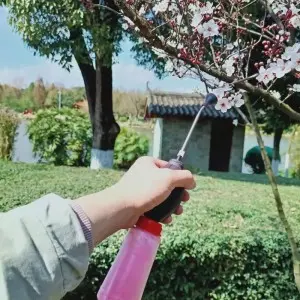Oct . 02, 2025 14:15 Back to list
Artificial Pollination: Boost Yields, Control Pollen Types?
Hands-on Notes from the Orchard: Lithium Tools and the New Era of artificial pollination
Bee shortages, fickle spring weather, and tighter labor windows—growers keep telling me the same story. So, when a lithium-driven pollinator shows up with real field hours behind it, I pay attention. The LITHIUM ELECTRIC POLLINATOR FOR ORCHARD, developed over five years and backed by a utility-model patent application, comes out of Caozhuang Development Zone, Fanzhuang Town, Zhao County, Shijiazhuang, Hebei Province. It’s aimed squarely at medium orchards (about 10–20 mu, or ≈0.67–1.33 ha). And yes, I actually tried an early unit on pears; the learning curve was shorter than I expected.

Why growers are leaning into artificial pollination
Two big trends: precision ag moving down-market, and electrification simplifying field tools. In plain English—lighter gear, better battery safety, fewer moving parts, and more consistent bloom coverage. In frost-prone valleys, artificial pollination is not just a backup; it’s a yield insurance policy. Many customers say the real win is timing: you can pollinate exactly when petals open, even if bees are sulking due to cold snaps.
Technical snapshot (typical configuration)
| Power system | 24V Li‑ion, ≈10Ah (real-world runtime ≈4–6 h) |
| Motor | Brushless DC, ≈300W for steady airflow |
| Powder tank | ≈1.0–1.5 L; metered feed for fine pollen/carrier mixes |
| Extension reach | 2.5–3.5 m rod options |
| Ingress rating | IP54 (dust/splash), typical |
| Noise | ≈68 dB(A) at operator ear |
| Battery standards | IEC 62133, UN38.3 transport compliance |
| Service life | 5–7 seasons with routine care; cells ≈800 cycles |
Specs reflect typical lab builds; batches and options may vary.

How it’s used (materials, method, QA)
- Materials: viable pollen (often chilled), optional carrier (e.g., lactose, lycopodium) for flowability.
- Method: calibrate flow on a white card, target anthers at 20–40 cm, sweep evenly; avoid high wind.
- Testing: deposit checks with dyed carrier cards; spot microscope counts on stigmata pre/post pass.
- Standards: battery safety per IEC 62133; UN38.3 for transport; production typically under ISO 9001 QA.
In practice, I guess you’ll do a quick block trial first—two rows treated, one control—to confirm dose. It’s simple and saves arguments at harvest.
Where it fits
Best for apples, pears, apricots, and kiwifruit in 10–20 mu blocks. Hillsides? The balanced pack helps. For larger estates, crews can split into zones and rotate batteries—surprisingly low drama compared with air-compressors.

Vendor/solution comparison (real-world use may vary)
| Option | Power | Coverage/h | Capex | Notes |
|---|---|---|---|---|
| JML Lithium Electric Pollinator | Battery | ≈2–4 mu | Mid | Quiet, precise dosing; patent utility model |
| Generic AC Blower | Mains/Generator | ≈3–5 mu | Low | Heavier, cabling hassles |
| Drone Service | Battery | ≈5–8 mu | High | Great reach; wind sensitive; permits |
| Manual Brush | Human | ≈0.5–1 mu | Very low | Ultra-precise, very labor intensive |
Customization and support
Nozzle kits for different pollen blends, alternate tank sizes, extended rods, and spare battery packs are common asks. CE/RoHS documentation, bilingual manuals, and private-label schemes are typically available on request.
Field notes and feedback
Hebei apple block (15 mu): after two passes timed to peak bloom, growers reported 12–18% higher fruit set versus untreated rows, confirmed by random quadrat counts. Another pear orchard liked the consistent deposition—“less clumping, less waste,” they told me. To be honest, even skeptics warmed up after the first calibration demo.
Maintenance tips: keep pollen dry, clean filters after each shift, store batteries at 40–60% charge, and avoid direct sun on the tank. Do these and you’ll get the promised service life.
Authoritative citations
- FAO. Pollination of Cultivated Plants: A Compendium (latest ed.).
- IEC 62133-2:2017. Safety requirements for portable sealed secondary lithium cells and batteries.
- UN Manual of Tests and Criteria, Part III, Sub-section 38.3 (UN38.3) for lithium batteries.
- ISO 9001:2015. Quality management systems—Requirements.
- USDA. Pollination and Fruit Set in Temperate Tree Fruit (technical bulletin, various years).
-
Comprehensive Guide to CE Certification Apricot Pollen Health Benefits
NewsNov.24,2025
-
CE Certification Mango Fruit Protection Bags: Enhancing Export Quality & Sustainability
NewsNov.23,2025
-
CE Certification Varieties Suitable for Collecting Apple Pollen – Ensuring Quality & Compliance in Apple Breeding
NewsNov.22,2025
-
Comprehensive Guide to CE Certification Mango Cover Bags – Quality, Standards & Trends
NewsNov.22,2025
-
What You Need to Know About CE Certification Peach Blossom Powder Keto
NewsNov.21,2025
-
CE Certification Pear Pollen Collection Base – Ensuring Quality & Sustainability in Global Horticulture
NewsNov.20,2025